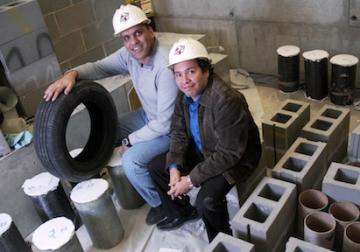Scrap tires could gain a new purpose as ingredients for construction materials, thanks to research at Missouri University of Science and Technology.
Discarded tires are a big problem. Landfills are teeming with them and they can harbor disease-carrying mosquitos and rodents. Stockpiles of old tires also burn easily — creating fires that can quickly get out of control and may burn for months or even years.
But the longevity and resilience of scrap tires also makes them ideal for other uses.
Dr. Mohamed A. El Gawady, a researcher at Missouri S&T, is currently testing new masonry blocks made with ground tires.
“Rubber has a lot of benefits in addition to its sustainability,” says El Gawady, associate professor of civil, architectural and environmental engineering. “It’s very durable and provides good insulation. Among their many potential benefits, these new blocks could cut heating bills by 50 percent.”
ElGawady has been working with Midwest Block and Brick, a Jefferson City, Mo.-based company, to create the blocks, which are made from sand and scrap tires ground to fine particles.
These rubber-added blocks, called rubberized blocks, were constructed with a variety of ratios of sand to rubber particles before coming up with the right balance.
“The rubber makes the blocks a bit weaker, so after testing various percentages, we now only replace about 20 percent of the sand with rubber, so the blocks retain their strength,” ElGawady says.
He and his students use a compression machine to test and compare the strength of prisms built with the rubberized blocks to conventional concrete masonry blocks.
Both rubberized and conventional blocks are being tested in an environmental chamber at Missouri S&T. In the chamber, the blocks undergo cycles of extreme temperatures and humidity levels, simulating different weather conditions. The rubberized blocks are also tested under cyclic compression loads simulating earthquake loads.
“Construction with these new blocks could improve a building’s resiliency during an earthquake by acting as shock absorbers,” says ElGawady.
Related Stories
Adaptive Reuse | Mar 26, 2024
Adaptive Reuse Scorecard released to help developers assess project viability
Lamar Johnson Collaborative announced the debut of the firm’s Adaptive Reuse Scorecard, a proprietary methodology to quickly analyze the viability of converting buildings to other uses.
Security and Life Safety | Mar 26, 2024
Safeguarding our schools: Strategies to protect students and keep campuses safe
HMC Architects' PreK-12 Principal in Charge, Sherry Sajadpour, shares insights from school security experts and advisors on PreK-12 design strategies.
Green | Mar 25, 2024
Zero-carbon multifamily development designed for transactive energy
Living EmPower House, which is set to be the first zero-carbon, replicable, and equitable multifamily development designed for transactive energy, recently was awarded a $9 million Next EPIC Grant Construction Loan from the State of California.
Museums | Mar 25, 2024
Chrysler Museum of Art’s newly expanded Perry Glass Studio will display the art of glassmaking
In Norfolk, Va., the Chrysler Museum of Art’s Perry Glass Studio, an educational facility for glassmaking, will open a new addition in May. That will be followed by a renovation of the existing building scheduled for completion in December.
Sustainability | Mar 21, 2024
World’s first TRUE-certified building project completed in California
GENESIS Marina, an expansive laboratory and office campus in Brisbane, Calif., is the world’s first Total Resource Use and Efficiency (TRUE)-certified construction endeavor. The certification recognizes projects that achieve outstanding levels of resource efficiency through waste reduction, reuse, and recycling practices.
Office Buildings | Mar 21, 2024
Corporate carbon reduction pledges will have big impact on office market
Corporate carbon reduction commitments will have a significant impact on office leasing over the next few years. Businesses that have pledged to reduce their organization’s impact on climate change must ensure their next lease allows them to show material progress on their goals, according to a report by JLL.
Adaptive Reuse | Mar 21, 2024
Massachusetts launches program to spur office-to-residential conversions statewide
Massachusetts Gov. Maura Healey recently launched a program to help cities across the state identify underused office buildings that are best suited for residential conversions.
Legislation | Mar 21, 2024
Bill would mandate solar panels on public buildings in New York City
A recently introduced bill in the New York City Council would mandate solar panel installations on the roofs of all city-owned buildings. The legislation would require 100 MW of solar photovoltaic systems be installed on public buildings by the end of 2025.
Office Buildings | Mar 21, 2024
BOMA updates floor measurement standard for office buildings
The Building Owners and Managers Association (BOMA) International has released its latest floor measurement standard for office buildings, BOMA 2024 for Office Buildings – ANSI/BOMA Z65.1-2024.

















